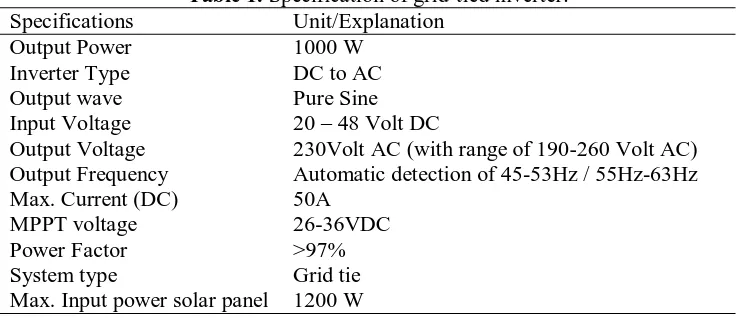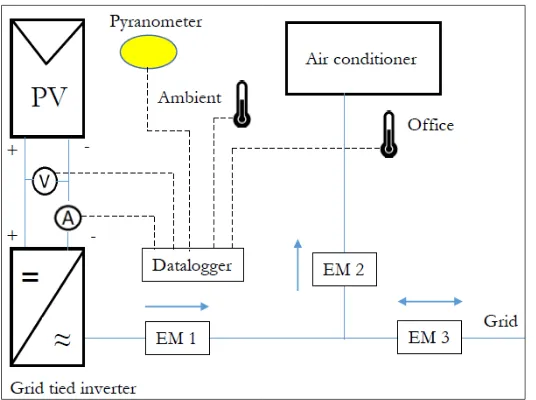PAPER • OPEN ACCESS
Performance test of a grid-tied PV system to
power a split air conditioner system in Surabaya
To cite this article: E Tarigan 2017 IOP Conf. Ser.: Mater. Sci. Eng. 273 012010
View the article online for updates and enhancements.
Related content
Experimental study on heat transfer performance of aluminium foam parallel-flow condenser in air conditioner
X Zhang, Z M Wan, H W Chang et al.
-Refrigeration oils for low GWP refrigerants in various applications
R Saito and S G. Sundaresan
-Multi-load Groups Coordinated Load Control Strategy Considering Power Network Constraints
Meng Liu, Binchao Zhao, Jun Wang et al.
Performance test of a grid-tied PV system to power a split air
conditioner system in Surabaya
E Tarigan
Department of Electrical Engineering, University of Surabaya, Raya Kalirungkut, Surabaya 60293, Indonesia
E-mail: [email protected]
Abstract. Air conditioner for cooling air is one of the major needs for those who live in hot climate area such as Indonesia. This work presents the performance test of a grid-tied PV system to power air conditioner under a hot tropical climate in Surabaya, Indonesia. A 800 WP grid-tied photovoltaic (PV) system was used, and its performance was tested to power a 0.5 pk of split air conditioner system. It was found that about 3.5 kWh daily energy was consumed by the tested air conditioner system, and about 80% it could be supplied from the PV system. While the other 20% was supplied by the grid during periods of low solar irradiation, 440 Wh of energy was fed into the grid during operation out of office hours. By using the grid-tied PV system, the energy production by PV system did not need to match the consumption of the air conditioner. However, a larger capacity of PV system would mean that a higher percentage of the load would be covered by PV system.
1. Introduction
Solar energy is one of the most promising renewable energy resources that can be expected to reduce fossil fuels consumption, and in turn to reduce the emission of greenhouse gas in the atmosphere. New innovative solutions need to be attempted in both engineering and policy to promote the solar energy use. Air conditioner for cooling air is one of the major needs for those who live in hot climate area such as Indonesia; even air conditioning is commonly used during all year round. About 50%–60% of buildings energy are commonly from air conditioning needs [1].
For its location that is very close to the equator line, solar irradiation in Surabaya, Indonesia, is relatively high, ranging from 4.8–5.8 kWh/m².day [2]. The ambient temperature is also relatively high with an average of 32 °C and 30 °C during dry and wet season, respectively [3]. Therefore, cooling demands for a building is very high throughout the year. On the other hand, solar electricity should be a good option to supply energy for cooling. Surabaya is suitable location to perform the possibility of using air conditioners powered by photovoltaic. The result can be a reference or adopted to other countries or cities with similar weather.
2
found that the exploitation of the results of the simulation provided the optimum sizing of the solar system. The studies provided a good guideline in a design process
Aguilar et al. [6] reported a study of employing PV panels to supply electricity to power the compressor of the inverter for an air conditioner unit without batteries or any regulator. Here the inverter of the air conditioner was connected to both PV panels and grid. One advantage of using an inverter air conditioner was that it uses. The advantage of such system is the using of the direct current directly from the photovoltaic without inverter, that means reducing cost and increasing the efficiency energy conversion.
The peak time of using air conditioner for an office is commonly during the day when the hot weather (high solar radiation) and temperature is high, on the other hand at the same time PV panels produces electricity at optimum. In the present work, a grid-tied PV system was tested for its performance to power a split air conditioner under a hot tropical climate in Surabaya, Indonesia. The solar fraction and the advantages and limitation of such system were discussed.
2. Methods
Grid-tied PV system components consist of: 800 Wp monocrystalline silicon (4 modules of @200 Wp) connected with a 1000 Watt of the grid-tied inverter. The specification of the grid-tied inverter
Output Voltage 230Volt AC (with range of 190-260 Volt AC)
Output Frequency Automatic detection of 45-53Hz / 55Hz-63Hz
Max. Current (DC) 50A - the AC output power from the inverter, - solar radiation,
- inside and outside temperatures, - power consumption air conditioner, - The start-up power of the air conditioner.
Figure 1. Experiment and measurement devices schematically.
3. Results and discussion
The air conditioner system was set on the temperature of 22 °C and ran during 07:30 to 17:30 fitting with typical office hours period and condition of a typical office in Indonesia. The power consumption of the air during the office hours was approximately 350W and total energy demand is about 3.45 kWh/day. The power rate of air conditioner system over time is shown in Figure 2.
Figure 2. Power consumed by 0.5 pk air conditioner.
4
Figure 3. Diurnal variation of AC power, PV power, Backup power, Irradiance and Feed in power.
Figure 3 shows the typical one day measurement results for a sunny day. The figure shows the diurnal variation of the power consumed by the air conditioner, power from PV systems, backup power by the grid, solar irradiance and the feed-in power. It displays how the air conditioning, PV system, and the sun work together. It can be interpreted that during 05:30–07:30 when the air conditioner system was still off, the energy produced by PV was fed into the grid. When theair conditioner was switched on at07:30 the energy production by PV was still too low to fully run the air conditioner. Therefore some portion of power was supplied by the grid. A significant high of power was also needed from the grid for the air conditioner start-up. However, it could not be seen in the graph as it happened in very short of periods (less than a second). From 08:00 irradiance and PV production continued to rise,and the powerproduced reached 450 W. While air conditioner power consumption was at the levelof 350 W means that 100 W excess energy was exported into the grid. This condition was continuously happening until about 14.00. From 14:00–14:40 solar radiation was decreasing and power produced by PV was getting lower, resulting in decreasing of feed in power. From 14:40 the PV system obviously could nolonger fully power the air conditioner, and then the backup power from the grid slowly increased until 17:00 when it was fully powered by the grid, and at 17:30 it switched off.
From results for four consecutive days of experimentas presented in Table 2, it was found that about 3.45 kWh was needed daily by the air conditioner system for running during office hour, and 80% of it (about 2.7 kWh) was supplied by PV panels as called solar fraction. The energy produced by PV system during period of before and after office hour was about 440 Wh. That means that PV panel almost supply all of energy needed by the air conditioner systems.
second function of the backup power from the grid was to power the air conditioner during start-up. This means to eliminate the need to oversize the inverter which is related to the cost and efficiency.
Table 2. Experiment results for four consecutive days for period of 7.30–17.30.
Day Average power powered air conditioning. The advantages of the system are its simple system means less complexity of the PV system; low cost as it does not need batteries and charge controller; reliable; no need oversized inverter; the possibility of exporting excess electricity; and adaptable. The government of Indonesia is introducing a feed-in tariff policy for renewable energy resources [7]. If this is applied, a grid-tied system would be more attractive. The limitations of grid-tied system are, it is not 100% powered by PV system, weather dependent, and it is not functioned during blackouts.
4. Conclusion
A 800 WP grid-tied photovoltaic (PV) system has been tested to power a 0.5 pk of split air conditioner system. About 3.5 kWh daily energy was consumed by the air conditioner system, and about 80% of it could be supplied from the PV system, while the other 20% was supplied by the grid during periods of low solar irradiation, and 440 Wh of energy was fed to the grid during out of office hours operation. A grid-tied PV system is considerably the best solution for a PV powered air conditioning where the grid is available. The advantages grid-tied system are the simplicity of the system; low cost in comparison with off grid system; reliable; no need for oversized inverter; the possibility of exporting excess electricity; and adaptable.
References
[1] Fong K F, Lee C K and Chow T T 2012 Comparative study of solar cooling systems with building-integrated solar collectors for use in sub-tropical regions like Hong Kong Appl. Energy 90 pp 189–195
[2] Tarigan E, Djuwari and Purba L 2014 Assessment of PV power generation for household in Surabaya using solar GIS-pvplanner simulation Energy Procedia 47 pp 85–93
[3] Tarigan E, Djuwari and Kartikasari F D 2015 Techno-economic simulation of a grid-connected PV system design as specifically applied to residential in Surabaya, Indonesia Energy Procedia65 pp 90–99
[4] Daut I, Adzrie M, Irwanto M, Ibrahim P and Fitra M 2013 Solar powered air conditioning system Energy Procedia 36 pp 444–453
[5] Tsoutsos T, Aloumpi E, Gkouskos Z and Karagiorgas M 2010 Design of a solar absorption cooling system in a Greek hospital Energy Build 42 pp 265–272
[6] Aguilar F J, Quiles P V and Aledo S 2014 Operation and energy efficiency of a hybrid air conditioner simultaneously connected to the grid and to photovoltaic panels Energy Procedia 48 pp 768–777



